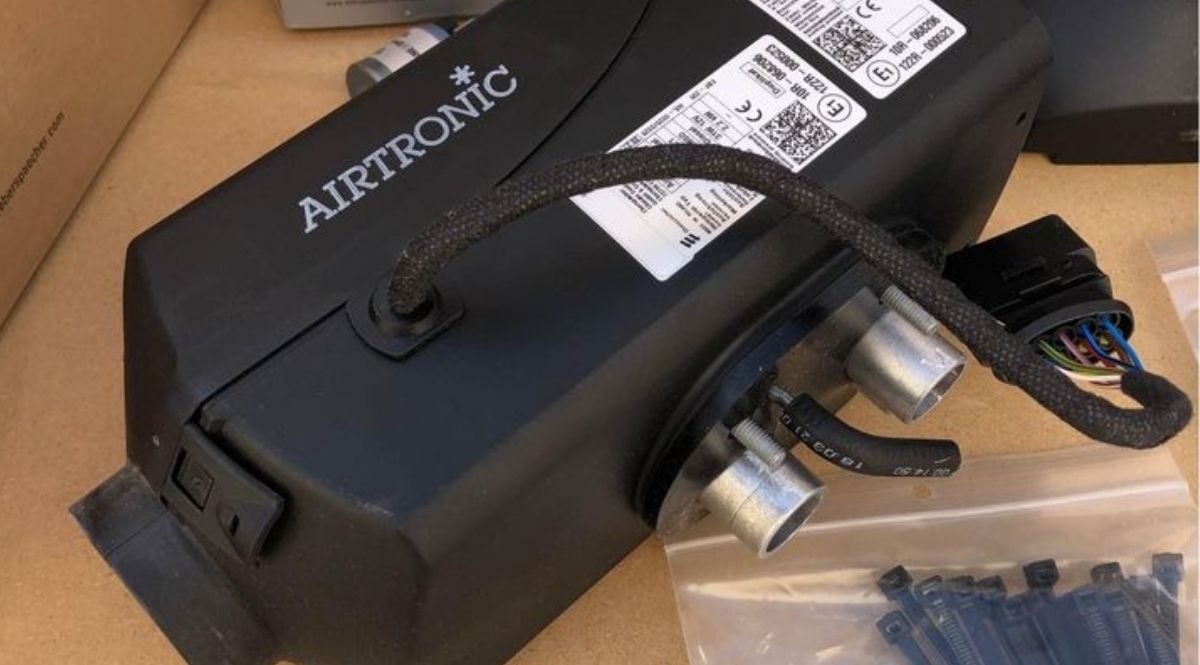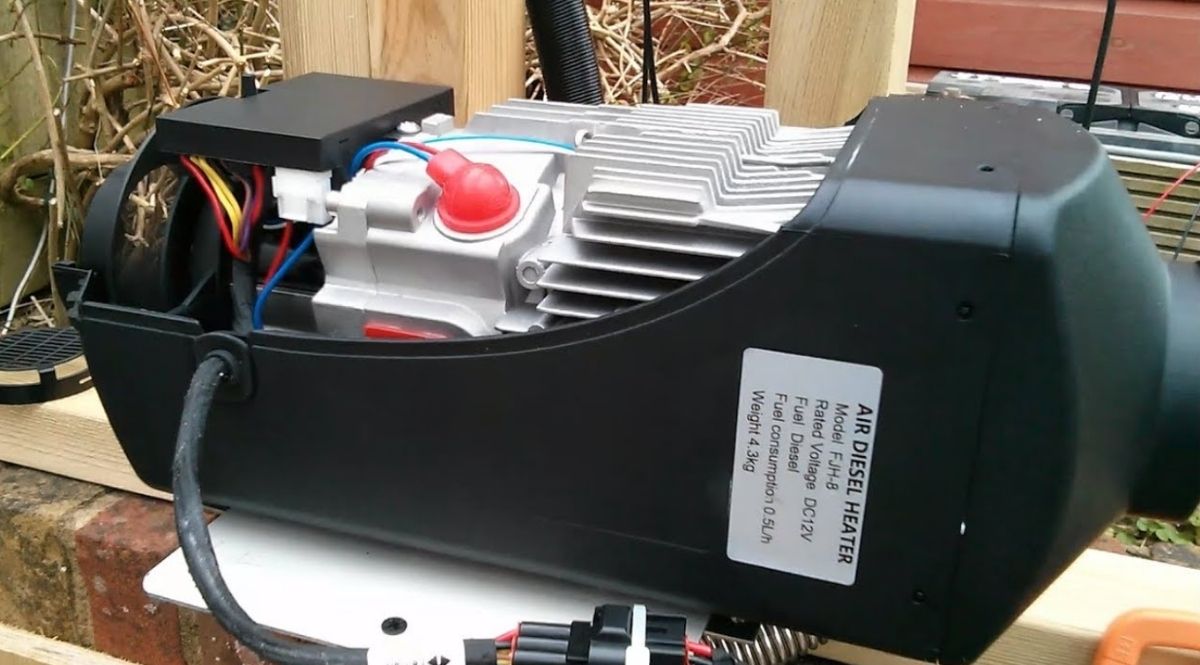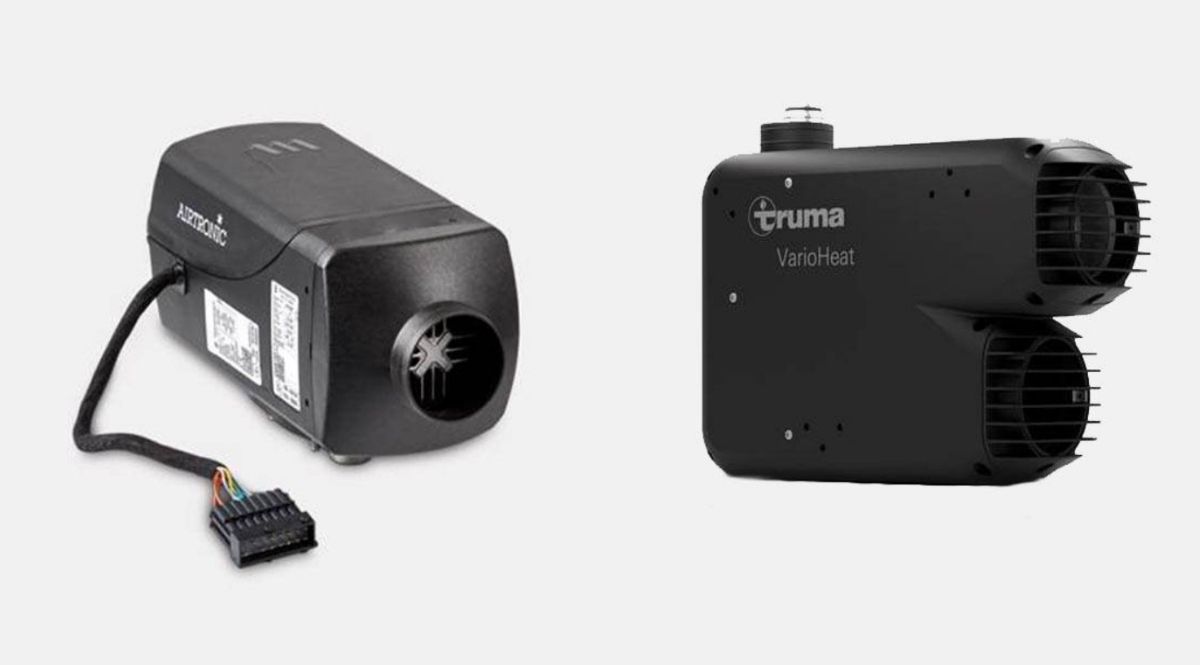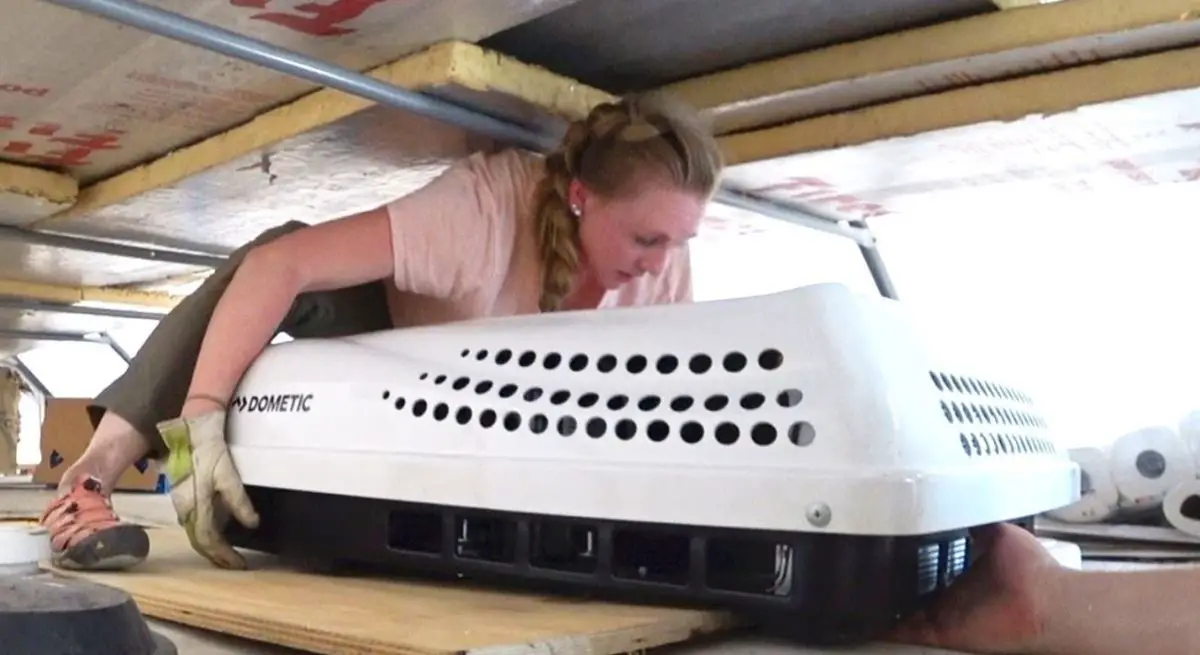Do Diesel Heaters Stink?
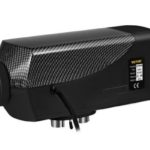
When a diesel heater is first turned on, you may smell the fuel, but the smell doesn’t last. The smell comes from the initial release of the diesel that hasn’t burned off yet. Once the heater is up and running, there should be no odor inside the RV.
Because the combustion system of your RV and the diesel heater’s heating system is entirely separate, you won’t be exposed to hazardous fumes while spending time inside your RV, making diesel heaters safe to use without fear of smell.
If there is a smell inside the RV from the diesel heater, turn it off and air out the RV. Then, double-check your ventilation. If the heater isn’t properly ventilated, you should refrain from using it until the issue can be fixed.
Do You Need A Silencer/Muffler On A Diesel Heater?

A muffler is not necessary on a diesel heater, but it can help reduce the noise level and protect the eardrums. If your diesel heater is particularly loud, a muffler can make the sound more manageable for yourself and those around your RV. Some models come with a muffler built-in, while others have an optional muffler that can be purchased separately.
The volume of some diesel heaters can reach around 70dB. The EPA and WHO recommend keeping environmental noise at less than 70dB over the course of 24 hours to prevent permanent damage to the eardrums. A muffler can quickly bring the noise down to the 40 – 50 dB range, thus making it safer for you.
Are Low-Cost Diesel Heaters Safe?
Low-cost diesel heaters, like those made in China, can be less safe than those made in Europe. While this isn’t true for all brands, many Chinese heaters are difficult to install due to the poor translation or lack of instructions and are often missing vital components to operate correctly.
They are also more prone to fires and can have inadequate wiring, faulty glow plugs, and smoky exhaust emissions. Your best bet is to spend a few extra dollars and get a tried-and-true brand like Webasto and Espar.
How Much Power Does A Diesel Heater Use?
The amount of power a diesel heater uses depends on its size. The heater will use the most power on startup, with a range being 8 to 15 amps. Once the heater is running, it can use four amps or less, depending on size and model.
Diesel heaters are very fuel-efficient, but you should avoid attaching them to your car battery as this can reduce the life of the battery. It is recommended by many RV’ers only to use the diesel heater at night. If you only use the heater at night, you can expect to use a gallon of fuel.
Can You Use Gasoline in A Diesel Heater?
Unless specifically designed to work with gas, you should not use gas in a diesel heater. Gas isn’t designed to be exposed to a direct flame, and many diesel heaters work this way. Don’t assume that the diesel heater you own can run on gasoline or other fuels.
Heaters that can run on gas are a good idea for those who have vans that don’t use diesel fuel to run. This can make it easier and more convenient in the long run.
What Sizes Do Diesel Heaters Come In?
Diesel heaters come in 2kW, 5kW, and 8kW options. A 2kW diesel heater is sufficient for vans and RVs less than 21 feet long. Anything longer, like a Class A or Class C motorhome, you may want a 5kW heater.
While a 2kW heat can warm a longer RV, it will take much more time and therefore use more energy. A 5kW heater will be able to warm up the motorhome in much less time. 8kW diesel heaters are not common for RV owners as they are overkill and can waste fuel.
Does A Diesel Heater Produce Carbon Monoxide?
Diesel heaters are safe to run inside of an RV or van, but they do produce carbon monoxide. If properly installed and ventilated, the carbon monoxide won’t pose any danger as they have a sealed combustion chamber. Keep in mind that the fumes can still cause you to feel funny, even in small doses.
Ventilation is important; the carbon monoxide produced by a diesel engine can be harmful to your health if breathed in for long periods of time. It is also tasteless and odorless, making it tough to detect. Many people choose to install more than one carbon monoxide detector in their RV as an extra safety measure.
Do Diesel Heaters Have A Catalytic Converter?
Most diesel heaters do not have a catalytic converter, but one can be installed. A catalytic converter is important as it helps to reduce the harmful emissions that are produced by the heater. If you are concerned about the environment or your own health, choose a model with a catalytic converter or consider installing one on your current heater. If these options don’t work, there are catalytic heaters available that don’t produce carbon monoxide and are safe to operate in an enclosed location.
Does A Diesel Heater Have Glow Plugs?
Glow plugs help to preheat the air in the combustion chamber, making it easier for the diesel to ignite, making them an important part of a diesel heater. If your heater doesn’t have glow plugs, it may take longer for the heater to start up, but it will still operate as normal.
Glow plugs will need to be replaced or cleaned every so often. The timeframe for the cleaning depends on how often the heater is used. It may not be necessary to clean the glow plugs until you notice it takes longer to fire up the heater.
Do Diesel Heaters Have A Thermostat?
Many diesel heaters come with a thermostat, but not all of them do. This is a good feature to look for when shopping for a diesel heater as it allows you to control the temperature of the heater, ensuring that you don’t use more fuel than necessary.
Here is a good example of a heater with an LCD intake pipe thermostat. Don’t assume the diesel heater you buy will come with a thermostat. If fuel is a big concern, investing in a diesel here with a thermometer is the way to go.
Can You Add A Thermostat to A Diesel Heater?
If your diesel heater doesn’t come with a thermostat, you may be able to add one yourself. Check the instructions that came with your heater to see if this is possible. That being said, there are many places online where you can find instructions to install a DIY thermostat for your diesel heater.
Keep in mind this might not be easy for everyone, so if you are not comfortable adding a thermostat to your heater, you may want to consult a professional to see if they can install a thermostat for you. If your heater is on the older side, you can consider upgrading to a new model with a built-in thermostat.
Can You Run A Diesel Heater While Driving?
Not all diesel heater manufacturers recommend running the heater while driving. Suppose you can wait until you are parked to start the heater. Of course, it will depend on the diesel heater you have and the layout of your RV or van. If there is any concern about ventilation, running the heater while driving can be dangerous as it can cause carbon monoxide to build up in the cabin. If you must run the heater while driving, make sure to crack a window to ensure proper ventilation.
How Long Do Diesel Heaters Last?
Diesel heaters can last for many years if they are properly maintained. Many US and European brand diesel heaters can last eight to 10 years. If you choose to spend less money and purchase a Chinese model, there is a possibility it might only last you around three years.
If you take care of your heater and follow the manufacturer’s instructions and perform regular maintenance, you can expect your heater to last for a long time. Also, keep in mind certain parts can be replaced periodically to increase the lifespan. Some of these include the glow plugs and the fuel pump.
Does A Diesel Heater Have A Fuel Pump?
A functioning fuel pump is one of the most important parts of a diesel heater. The job of a fuel pump is to make sure the engine gets an adequate amount of fuel to provide ample heat. If you find your diesel heater isn’t working as well as it once used to or that it’s using a lot more fuel than before, this could be due to a faulty fuel pump.
When replacing a fuel pump, quality does matter. Many brands will be louder than others. If having a noisy fuel pump it’s a deal-breaker for you, make sure you do some research and find a model that is quite enough for your needs.
Who Makes The Best Diesel Heaters?
There are many different brands of diesel heaters on the market, and it can be difficult to choose the best one. Some of the best diesel heaters on the market are made by Espar and Webasto. While they are more expensive than the Chinese model diesel heaters, they will typically last longer, be more fuel-efficient and come with a warranty. This isn’t to say all Chinese brand heaters aren’t worth the money, but they should be vetted more extensively before purchasing.
How Often Do Diesel Heaters Need Servicing?
Diesel heaters usually need to be serviced once a year. However, if you use your heater regularly, you may need to service it more often. Heavy users may want to perform service every six months. It can also be performed whenever the heater isn’t working as well as it used to. This is due to carbon build-up on the inside of the combustion chamber.
One tip to keep carbon build-up to a minimum is to keep the heater on full blast for around one hour. This can burn off the carbon that has accumulated. An easy way to perform maintenance is to buy a maintenance kit for the heater. It will typically include a glow plug, replacement gaskets ( base, motor, and burner), and a burner cartridge.
How Do You Clean The Glow Plug On A Diesel Heater?
Cleaning glow plugs is a simple process and a good idea for maintenance and conserving fuel. The first step is to remove the glow plug from the engine, and the final is to clean the glow plug with brake cleaner. To accomplish this, you will need to remove the exhaust pipe (which should also be cleaned), remove the fuel line, and any other attachments.
Then the plate will need to be removed. This is a good opportunity to change the gasket under the plate if it has been a while. Remove the vent and the bottom panel, then the top panel should come right off, leaving the heater itself. Unscrew the circuit board and make sure you unplug the temperature sensor and other connections to the board before completely removing it to avoid damage.
Next, loosen the screws to remove the fan, and then you should be able to see the nut holding the glow plug in place. Loosen the nut and gently twist out the glow plug. Once the glow plug is removed, spray it down with brake cleaner. Then remove the build-up with a rag. Wait for the plug to dry before reassembling the heater fully.

